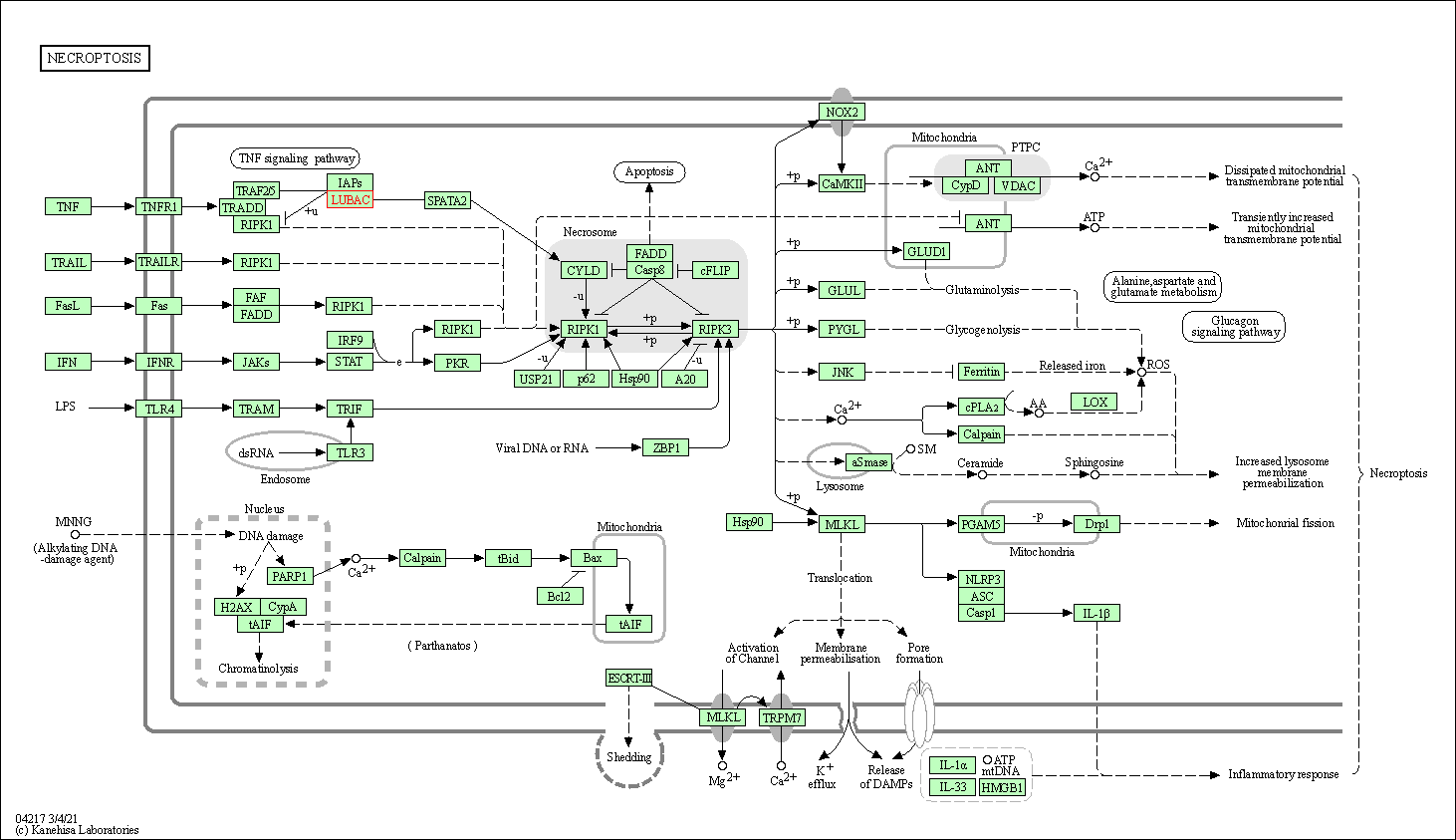Target Information
| Target General Information | Top | |||||
|---|---|---|---|---|---|---|
| Target ID |
T71055
(Former ID: TTDI00002)
|
|||||
| Target Name |
Linear ubiquitin chain assembly complex (RBCK1)
|
|||||
| Synonyms |
XAP4; XAP3; Ubiquitin-conjugating enzyme 7-interacting protein 3; UBCE7IP3; RanBP-type and C3HC4-type zinc finger-containing protein 1; RNF54; RING-type E3 ubiquitin transferase HOIL-1; RING finger protein 54; Hepatitis B virus X-associated protein 4; Heme-oxidized IRP2 ubiquitin ligase 1; HOIL-1; HBV-associated factor 4; C20orf18
Click to Show/Hide
|
|||||
| Gene Name |
RBCK1
|
|||||
| Target Type |
Literature-reported target
|
[1] | ||||
| Function |
Functions as an E3 ligase for oxidized IREB2 and both heme and oxygen are necessary for IREB2 ubiquitination. Promotes ubiquitination of TAB2 and IRF3 and their degradation by the proteasome. Component of the LUBAC complex which conjugates linear ('Met-1'-linked) polyubiquitin chains to substrates and plays a key role in NF-kappa-B activation and regulation of inflammation. LUBAC conjugates linear polyubiquitin to IKBKG and RIPK1 and is involved in activation of the canonical NF-kappa-B and the JNK signaling pathways. Linear ubiquitination mediated by the LUBAC complex interferes with TNF-induced cell death and thereby prevents inflammation. LUBAC is recruited to the TNF-R1 signaling complex (TNF-RSC) following polyubiquitination of TNF-RSC components by BIRC2 and/or BIRC3 and to conjugate linear polyubiquitin to IKBKG and possibly other components contributing to the stability of the complex. Together with OTULIN, the LUBAC complex regulates the canonical Wnt signaling during angiogenesis. Binds polyubiquitin of different linkage types. E3 ubiquitin-protein ligase, which accepts ubiquitin from specific E2 ubiquitin-conjugating enzymes, such as UBE2L3/UBCM4, and then transfers it to substrates.
Click to Show/Hide
|
|||||
| BioChemical Class |
Acyltransferase
|
|||||
| UniProt ID | ||||||
| EC Number |
EC 2.3.2.31
|
|||||
| Sequence |
MDEKTKKAEEMALSLTRAVAGGDEQVAMKCAIWLAEQRVPLSVQLKPEVSPTQDIRLWVS
VEDAQMHTVTIWLTVRPDMTVASLKDMVFLDYGFPPVLQQWVIGQRLARDQETLHSHGVR QNGDSAYLYLLSARNTSLNPQELQRERQLRMLEDLGFKDLTLQPRGPLEPGPPKPGVPQE PGRGQPDAVPEPPPVGWQCPGCTFINKPTRPGCEMCCRARPEAYQVPASYQPDEEERARL AGEEEALRQYQQRKQQQQEGNYLQHVQLDQRSLVLNTEPAECPVCYSVLAPGEAVVLREC LHTFCRECLQGTIRNSQEAEVSCPFIDNTYSCSGKLLEREIKALLTPEDYQRFLDLGISI AENRSAFSYHCKTPDCKGWCFFEDDVNEFTCPVCFHVNCLLCKAIHEQMNCKEYQEDLAL RAQNDVAARQTTEMLKVMLQQGEAMRCPQCQIVVQKKDGCDWIRCTVCHTEICWVTKGPR WGPGGPGDTSGGCRCRVNGIPCHPSCQNCH Click to Show/Hide
|
|||||
| 3D Structure | Click to Show 3D Structure of This Target | AlphaFold | ||||
| Cell-based Target Expression Variations | Top | |||||
|---|---|---|---|---|---|---|
| Cell-based Target Expression Variations | ||||||
| Different Human System Profiles of Target | Top |
|---|---|
|
Human Similarity Proteins
of target is determined by comparing the sequence similarity of all human proteins with the target based on BLAST. The similarity proteins for a target are defined as the proteins with E-value < 0.005 and outside the protein families of the target.
A target that has fewer human similarity proteins outside its family is commonly regarded to possess a greater capacity to avoid undesired interactions and thus increase the possibility of finding successful drugs
(Brief Bioinform, 21: 649-662, 2020).
Human Tissue Distribution
of target is determined from a proteomics study that quantified more than 12,000 genes across 32 normal human tissues. Tissue Specificity (TS) score was used to define the enrichment of target across tissues.
The distribution of targets among different tissues or organs need to be taken into consideration when assessing the target druggability, as it is generally accepted that the wider the target distribution, the greater the concern over potential adverse effects
(Nat Rev Drug Discov, 20: 64-81, 2021).
Human Pathway Affiliation
of target is determined by the life-essential pathways provided on KEGG database. The target-affiliated pathways were defined based on the following two criteria (a) the pathways of the studied target should be life-essential for both healthy individuals and patients, and (b) the studied target should occupy an upstream position in the pathways and therefore had the ability to regulate biological function.
Targets involved in a fewer pathways have greater likelihood to be successfully developed, while those associated with more human pathways increase the chance of undesirable interferences with other human processes
(Pharmacol Rev, 58: 259-279, 2006).
Biological Network Descriptors
of target is determined based on a human protein-protein interactions (PPI) network consisting of 9,309 proteins and 52,713 PPIs, which were with a high confidence score of ≥ 0.95 collected from STRING database.
The network properties of targets based on protein-protein interactions (PPIs) have been widely adopted for the assessment of target’s druggability. Proteins with high node degree tend to have a high impact on network function through multiple interactions, while proteins with high betweenness centrality are regarded to be central for communication in interaction networks and regulate the flow of signaling information
(Front Pharmacol, 9, 1245, 2018;
Curr Opin Struct Biol. 44:134-142, 2017).
Human Similarity Proteins
Human Tissue Distribution
Human Pathway Affiliation
Biological Network Descriptors
|
|
|
Note:
If a protein has TS (tissue specficity) scores at least in one tissue >= 2.5, this protein is called tissue-enriched (including tissue-enriched-but-not-specific and tissue-specific). In the plots, the vertical lines are at thresholds 2.5 and 4.
|


| KEGG Pathway | Pathway ID | Affiliated Target | Pathway Map |
|---|---|---|---|
| Necroptosis | hsa04217 | Affiliated Target |

|
| Class: Cellular Processes => Cell growth and death | Pathway Hierarchy | ||
| NOD-like receptor signaling pathway | hsa04621 | Affiliated Target |

|
| Class: Organismal Systems => Immune system | Pathway Hierarchy | ||
| Degree | 9 | Degree centrality | 9.67E-04 | Betweenness centrality | 7.39E-06 |
|---|---|---|---|---|---|
| Closeness centrality | 2.17E-01 | Radiality | 1.38E+01 | Clustering coefficient | 7.78E-01 |
| Neighborhood connectivity | 3.50E+01 | Topological coefficient | 2.20E-01 | Eccentricity | 11 |
| Download | Click to Download the Full PPI Network of This Target | ||||
| Target Regulators | Top | |||||
|---|---|---|---|---|---|---|
| Target-interacting Proteins | ||||||
| References | Top | |||||
|---|---|---|---|---|---|---|
| REF 1 | The linear ubiquitin chain assembly complex regulates TRAIL-induced gene activation and cell death. EMBO J. 2017 May 2;36(9):1147-1166. | |||||
If You Find Any Error in Data or Bug in Web Service, Please Kindly Report It to Dr. Zhou and Dr. Zhang.

